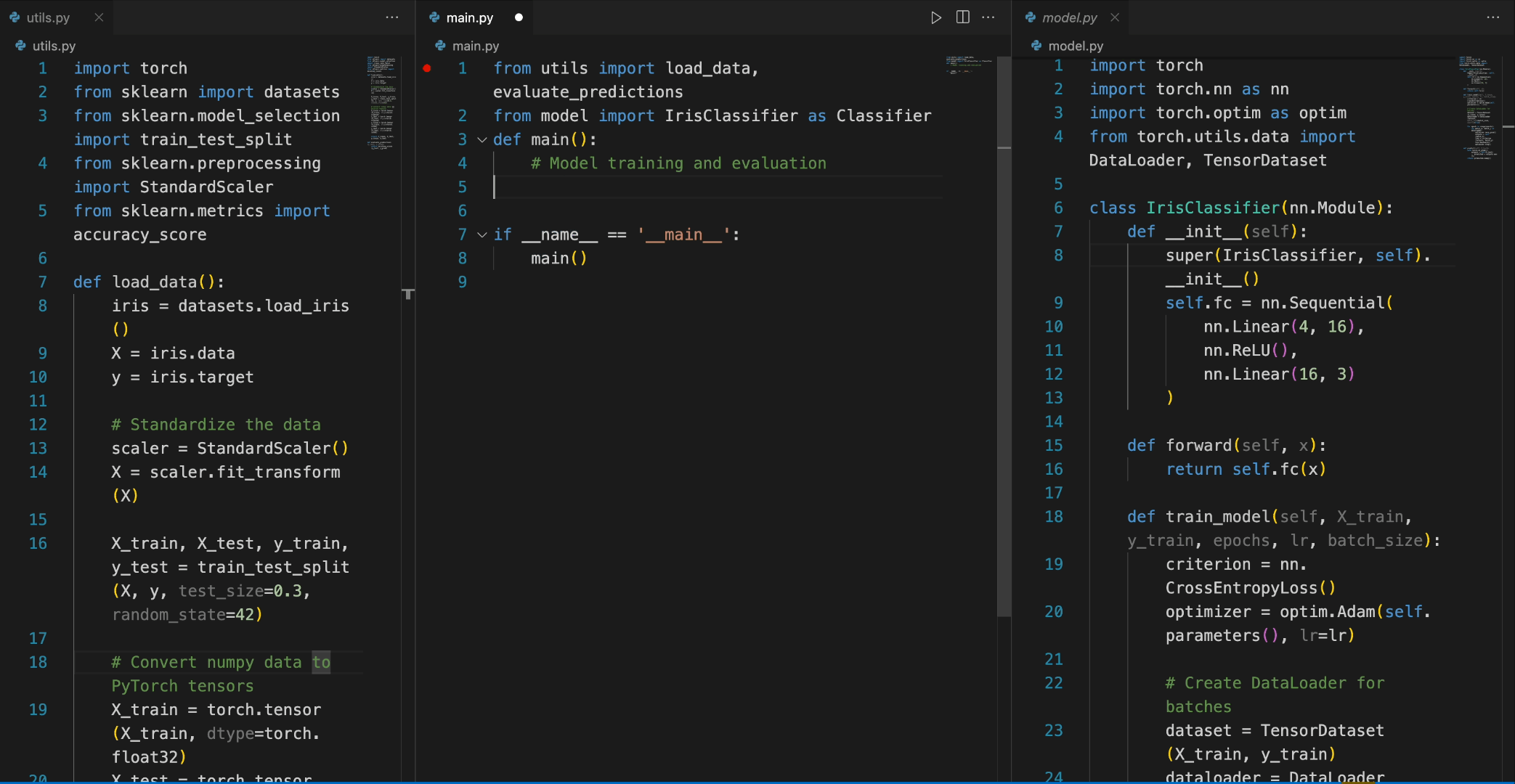7.8 KiB
[🏠 Homepage] | [🤖 Chat with DeepSeek Coder] | [🤗 Models Download] | [📄 中文版]
1. Introduction of Deepseek Coder
Deepseek Coder comprises a series of advanced language models trained on both 87% code and 13% natural language in English and Chinese, with each model pre-trained on 2T tokens. We provide various sizes of the code model, ranging from 1B to 33B versions. Each model is pre-trained on project-level code corpus by employing a window size of 16K and a extra fill-in-the-blank task, to support project-level code completion and infilling. For coding capabilities, Deepseek Coder achieves state-of-the-art performance among open-source code models on multiple programming languages and various benchmarks.
-
Massive Training Data: Trained on 2T tokens, including 87% code and 13% linguistic data in both English and Chinese languages.
-
Highly Flexible & Scalable: Offered in model sizes of 1B, 7B, and 33B, enabling users to choose the setup most suitable for their requirements.
-
Superior Model Performance: State-of-the-art performance among publicly available code models on HumanEval-X, MultiPL-E, MBPP, DS-1000, and APPS benchmarks.
-
Advanced Code Completion Capabilities: A window size of 16K and a fill-in-the-blank task, supporting project-level code completion and infilling tasks.
2. Procedure of Data Creation and Model Training
Data Creation
- Step 1: Collecting code data from GitHub and apply the same filtering rules as StarcoderData to filter data.
- Step 2: Parsing the dependencies of files within the same repository to rearrange the file positions based on their dependencies.
- Step 3: Concatenating dependent files to form a single example and employ repo-level minhash for deduplication.
- Step 4: Further filtering out low-quality code, such as codes with syntax errors or poor readability.
Model Training
- Step 1: Initially pre-trained with a dataset consisting of 87% code, 10% code-related language (Github Markdown and StackExchange), and 3% non-code related Chinese language. Models are pre-trained using 1.8T tokens and a 4K window size in this step.
- Step 2: Further Pre-training using an extended 16K window size on an additional 200B tokens, resulting in foundational models.
- Step 3: Instruction Fine-tuning on 300M tokens of instruction data, resulting in instruction-tuned models.
3. Download and Setup
Deepseek Coder is initially implemented in Pytorch and trained on A100 AI Processors. We provide a torch-compatible version based on hai-llm to facilitate usage on GPU platforms. We also uploaded the checkpoint of models to the 🤗 huggingface.
Setup
Python 3.8+ / CUDA 11+ / PyTorch 2.0+ / transformers 3.34+ are required.
4. Inference and Evaluation
Here give some examples of how to use our model.
Code Completion
from transformers import AutoTokenizer, AutoModelForCausalLM
tokenizer = AutoTokenizer.from_pretrained("deepseek/deepseek-coder-7b")
device = 0 if torch.cuda.is_available() else -1
model = AutoModelForCausalLM.from_pretrained("deepseek/deepseek-coder-7b").to(device)
inputs = tokenizer("def hello_world():", return_tensors="pt").to(device)
outputs = model.generate(**inputs, max_length=128)
print(tokenizer.decode(outputs[0], skip_special_tokens=True))
Code Insertion
from transformers import AutoTokenizer, AutoModelForCausalLM
tokenizer = AutoTokenizer.from_pretrained("deepseek/deepseek-coder-7b")
device = 0 if torch.cuda.is_available() else -1
model = AutoModelForCausalLM.from_pretrained("deepseek/deepseek-coder-7b").to(device)
input_text = "<fim_prefix>def print_hello_world():\n <fim_suffix>\n print('Hello world!')<fim_middle>"
inputs = tokenizer.encode(input_text, return_tensors="pt").to(device)
outputs = model.generate(**inputs, max_length=128)
print(tokenizer.decode(outputs[0]))
Repository Level Code Completion
from transformers import AutoTokenizer, AutoModelForCausalLM
tokenizer = AutoTokenizer.from_pretrained("deepseek/deepseek-coder-7b")
input_text = """#utils.py
import torch
from sklearn import datasets
from sklearn.model_selection import train_test_split
from sklearn.preprocessing import StandardScaler
from sklearn.metrics import accuracy_score
def load_data():
iris = datasets.load_iris()
X = iris.data
y = iris.target
# Standardize the data
scaler = StandardScaler()
X = scaler.fit_transform(X)
X_train, X_test, y_train, y_test = train_test_split(X, y, test_size=0.3, random_state=42)
# Convert numpy data to PyTorch tensors
X_train = torch.tensor(X_train, dtype=torch.float32)
X_test = torch.tensor(X_test, dtype=torch.float32)
y_train = torch.tensor(y_train, dtype=torch.int64)
y_test = torch.tensor(y_test, dtype=torch.int64)
return X_train, X_test, y_train, y_test
def evaluate_predictions(y_test, y_pred):
return accuracy_score(y_test, y_pred)
#model.py
import torch
import torch.nn as nn
import torch.optim as optim
from torch.utils.data import DataLoader, TensorDataset
class IrisClassifier(nn.Module):
def __init__(self):
super(IrisClassifier, self).__init__()
self.fc = nn.Sequential(
nn.Linear(4, 16),
nn.ReLU(),
nn.Linear(16, 3)
)
def forward(self, x):
return self.fc(x)
def train_model(self, X_train, y_train, epochs, lr, batch_size):
criterion = nn.CrossEntropyLoss()
optimizer = optim.Adam(self.parameters(), lr=lr)
# Create DataLoader for batches
dataset = TensorDataset(X_train, y_train)
dataloader = DataLoader(dataset, batch_size=batch_size, shuffle=True)
for epoch in range(epochs):
for batch_X, batch_y in dataloader:
optimizer.zero_grad()
outputs = self(batch_X)
loss = criterion(outputs, batch_y)
loss.backward()
optimizer.step()
def predict(self, X_test):
with torch.no_grad():
outputs = self(X_test)
_, predicted = outputs.max(1)
return predicted.numpy()
#main.py
from utils import load_data, evaluate_predictions
from model import IrisClassifier as Classifier
def main():
# Model training and evaluation
"""
inputs = tokenizer.encode(input_text, return_tensors="pt").to(device)
outputs = model.generate(**inputs, max_length=128)
print(tokenizer.decode(outputs[0]))
In the following scenario, the Deepseek-Coder 7B model effectively calls a class IrisClassifier and its member function from the model.py file, and also utilizes functions from the utils.py file, to correctly complete the main function inmain.py file for model training and evaluation.
Chat Model Inference
from transformers import AutoTokenizer, AutoModelForCausalLM
tokenizer = AutoTokenizer.from_pretrained("deepseek/deepseek-coder-7b")
prompt = "write a quick sort algorithm in python."
prompt = f"""Below is an instruction that describes a task, paired with an input that provides further context.\nWrite a response that appropriately completes the request.\n\n### Instruction:\nWrite a program to perform the given task.\n\nInput:\n{prompt}\n\n### Response:\n"""
inputs = tokenizer.encode(prompt, return_tensors="pt").to(device)
outputs = model.generate(**inputs, max_length=128)
print(tokenizer.decode(outputs[0]))



